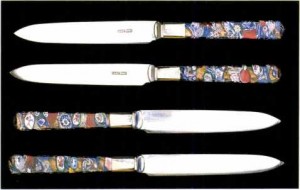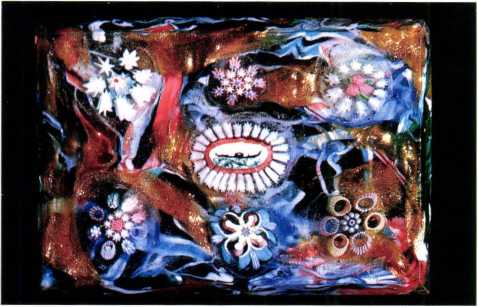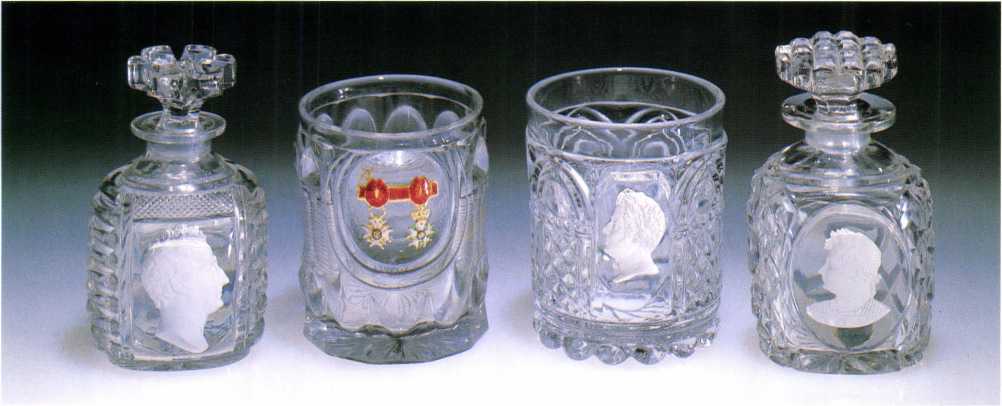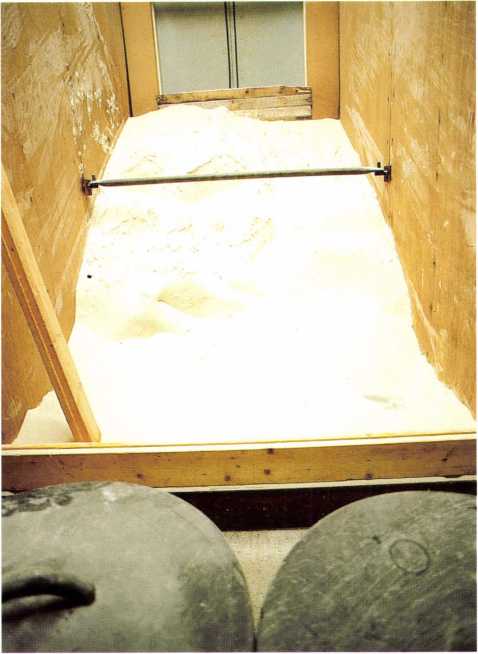PAPERWEIGHT PRESS
CALIFORNIA
Cover: Antique Saint Louis close concentric mushroom paperweight with torsade in blue nd white and a star-cut base, c. 1848.
© 1988 by Paperweight Press. All rights reserved
No part of this book may be reproduced or utilized in any form or by any means, electronic or mechanical, including photocopying, recording or by any information storage and retrieval systems, without written permission from the Publisher.
Inquiries should be addressed to Paperweight Press,
761 Chestnut Street, Santa Cruz, CA 95060.
First published 1988 Printed in Japan
Set in Janson Text using Aldus PageMaker
Library of Congress Cataloging-in-Publication Data Selman, Lawrence, 1938—
The art of the paperweight.
Bibliography: p.
Includes index.
1. Paperweights. I. Title.
NK5440.P3S43 1988 748.84
ISBN 0-933756-15-1
88-23186
Dedicated to
and especially to my sons, Matthew and Noah
Contents
Foreword ix
Preface xi
Acknowledgments xiii
| Chapter One: Beginnings | 3 | |
| Chapter Two: Varieties and Methods | 11 | |
| Chapter Three: Classic Period | 37 | |
| French Factories | 37 | |
| English Factories | 46 | |
| American Factories | 49 | |
| Chapter Four: Identification | 59 | |
| General Characteristics | 59 | |
| Millefiori | 67 | |
| Special Types of Paperweights | 90 | |
| Lampwork | 92 | |
| Miscellaneous Types | 111 | |
| Sulphides | 114 | |
| Paperweight-related Objects | 117 | |
| Chapter Five: Contemporary Makers | 121 | |
| Furnace Work | 122 | |
| Lampwork | 153 | |
| Cold Work | 181 | |
| Chapter Six: Collecting | 187 | |
| Appendices | 202 | |
| Glossary | 212 | |
| Bibliography | 218 | |
| Index | 220 |
Foreword
I often wonder what causes people to collect glass paperweights. Prices seem to spiral upward, so for many these weights may be investments. Unusual examples enter the market with surprising regularity, and they are often greeted with record-breaking enthusiasm. Many collectors cherish them for their beauty and fantasy. Are there other reasons to explain the mania? I can only answer from a personal point of view.
There are, of course, all of the obvious reasons. Paperweights are beautiful, but they are understated in ways that most Victorian-era glass is not, and they represent extraordinary’ craftsmanship. However, I admire paperweights primarily because they are the culmination of some 2,000 years of glassmaking artistry and experimentation.
When one looks at paperweights in terms of the history of glassmaking, one realizes that
there is little that makes them unique. The workmanship in a millefiori paperweight, for example, is no better than that perfected for the production of inlay plaques in ancient Alexandria in the first century B.C. During the Renaissance, Italian glassmakers also created millefiori canes that are nearly as complex as those made in midnineteenth century France, and they even encased them in decorative solid globes. The lampworked flowers found in paperweights are no more elaborate or delicate than the minute human figures created in Nevers, France, in the seventeenth and eighteenth centuries. There is, then, nothing new about paperweights.
Nevertheless, they are unique and important. The dome of colorless crystal provides the magic. One cannot easily see how the glassmaker formed and enclosed the tiny figures in the glass, or even even comprehend how small they really are because the solid dome magnifies everything within and forms a barrier to our touch. Cut facets, which appear to increase the number and reduce the size of the decorations, also add to the mystery. Visitors to our Museum stand in front of our paperweight display and ask, “How were they made?”
To understand just how important the “mystery” of the solid dome is, consider snowstorm paperweights. The magic of these weights may fascinate young minds, but it quickly pales for an adult who can easily figure out how it is done: the figure and the liquid are obviously added through an opening in the bottom.
I shall always remember (embarrassedly)that when I joined the staff of The Corning Museum of Glass, I considered paperweights boring. That opinion changed dramatically when I saw the wonderful examples in our collection. There is nothing like seeing, handling, and studying the best to learn about quality paperweights. Lawrence Selman’s newest book is useful to have by your side as you begin.
I have been working with the Museum’s weights for more than fifteen years, and I am pleased to report that I haven’t had a boring moment with them in all that time. I attribute their holding power to the fertile imaginations of their makers—makers who have mastered a demanding technology and demonstrated an elegant sense of design. Fortunately, we live in a time when these virtues are no less abundant . . . although it sometimes takes considerable effort to find the evidence. One need look no further than the pages of this book.
Dwight P. Lanmon Director
The Corning Museum of Glass
Preface
It is not known exactly why French glass factories pursued the making of paperweights with such intensity and vigor during a short twenty-year period in the mid-1800s. Perhaps the factories saw paperweights as a means of showing off their glassmaking skills or as a way of luring prospective customers from other glass houses. Perhaps these objects, which contain intricate millefiori designs and carefully constructed lampwork flowers and fruit, were a way glass craftsmen could exercise their creative and technical skills and experiment on a small scale.
Whatever the reasons may have been behind the making of paperweights, we are gifted with a unique body of work, created over a relatively short period of time, which nonetheless expresses a creative and technical peak in glassmaking history.
Glass paperweights from the classic period (1840-1860) have captivated collectors and historians for many years. These works have also inspired contemporary glassmakers and artists. We are indeed fortunate to be living in a time when paperweight making is experiencing a strong revival. A new generation of paperweight makers is carrying on in the classic tradition while utilizing modern technology and infusing their work with a contemporary vitality.
It is my hope that The Ait of the Paperweight will serve as a valuable tool for experienced collectors and students of paperweight and glass history. I also hope this book will provide an accessible and easy-to-understand introduction to a new generation of paperweight enthusiasts.
Lawrence H. Selman
Acknowledgments
This book is the culmination ol many years of study and the examination of thousands of paperweights. It also reflects the research and work done by many scholars and experts in the field of paperweights.
I would like to extend my gratitude to the following institutions, which have allowed us to include photographs of objects from their collections: the Bergstrom-Mahler Museum, Perthshire Paperweights, Saint Mary of the Barrens Seminary, Lundberg Studios, The Corning Museum of Glass, the Art Institute of Chicago, the Illinois State Museum, and the New York Historical Society, as well as numerous private collectors.
I am grateful to Paul Jokelson, T. H. Clarke, Paul Hollister, and Stuart Drysdale for their advice and valuable historical perspectives on the history and art of paperweight making. I wish to thank George Kulles, Dwight Lanmon, and Jerold Gard for critical readings of the text. Also, I would like to acknowledge the following institutions for making their archives and collections available and for their research assistance: Cris- talleries de Baccarat, The Corning Museum of Glass, and Lyons Ltd.
I thank the following contemporary paperweight artists for granting us interviews and providing us with information about modern paperweight production: Paul Stankard, Lundberg Studios, Parabelle Glass, David Salazar, James Shaw, Chris Buzzini, Randall Grubb, and Barry Sautner.
Finally I wish to thank Nikki Silva for researching this book; Jenny D’Angelo for editing the manuscript; Stephen Pollard for his typographical expertise; Lorraine Leung for designing the publication; and Lizann Keyes for proofreading; Franklin Avery, Paul Schraub, Covello Studios, and Nese Photography for the photographs; and the entire staff of L. H. Selman Ltd. and Paperweight Press for their dedication and hard work.
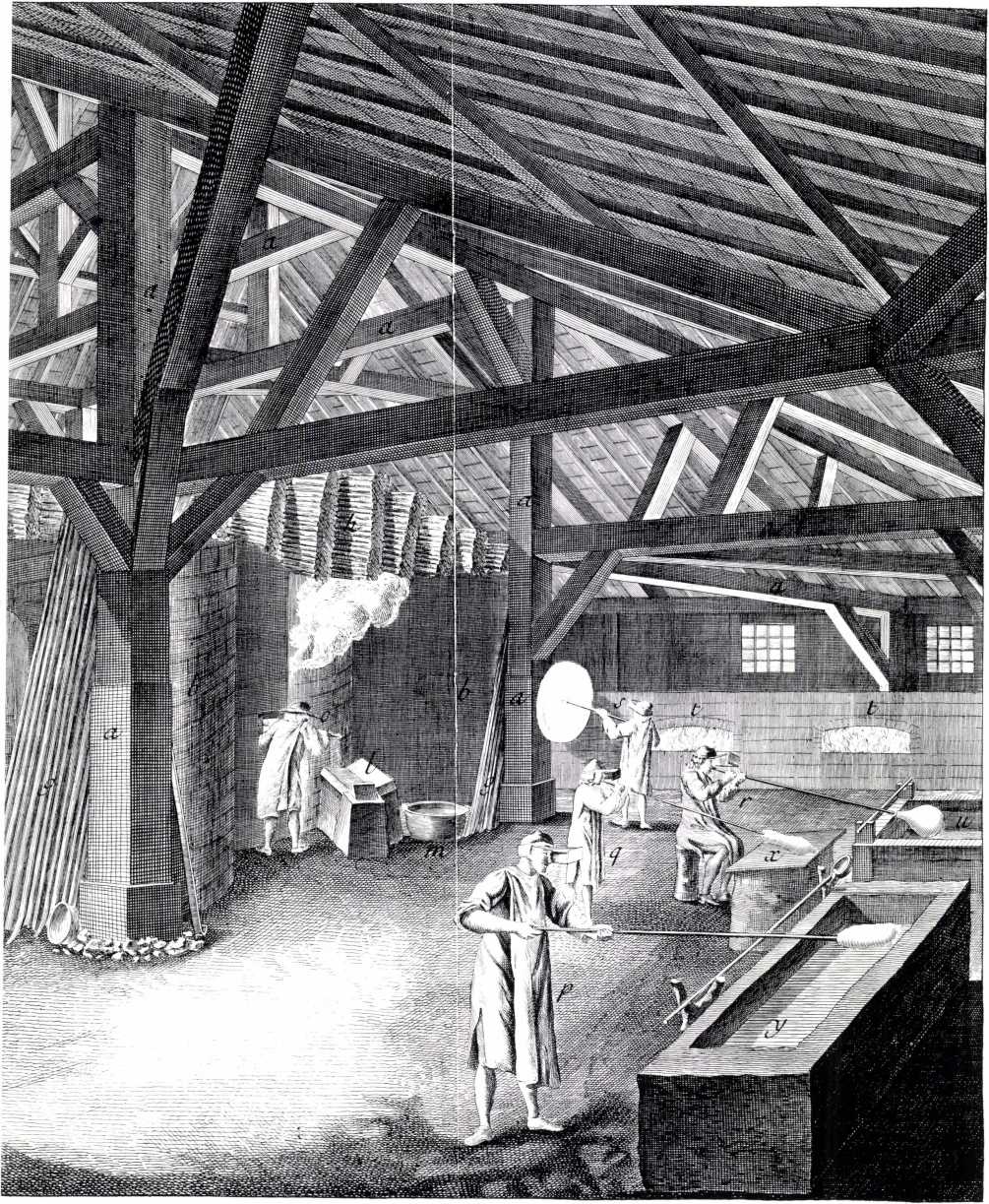
CHAPTER ONE
Beginnings
Glass is one of the most versatile and _ widely-used materials made by man. It is produced in countless forms and shapes. It can be transparent or opaque, rough or smoothly polished, colored or colorless, paper-thin or several feet thick. Glass historian Paul Hollister describes it:
I hate to use the word unique—because everyone uses it for the most trivial things—but glass is a unique material. It isn’t a gas, it isn’t an earth, it isn’t a crystal. In physics it’s called the fourth state of matter—it’s a supercooled liquid. And how it can he manipulated is just pure magic! It’s used for everything—clothing, telephone wires, coffins—it’s a universal material.
Although the uses of glass have expanded immensely since its first crude production, the lure and magic of the material continue. Ancient Egyptian glass vessels, highly decorated with patterns and ornaments, reveal that from its beginnings, glass inspired and compelled the artisans who worked with it. Even today, with the many advancements that have taken place in the field of glassmaking and the technical sophistication that has been achieved, the potential of glass as a decorative and artistic medium continues to hold a mystery and fascination for glassmakers and artists throughout the world.
First Glass
Scholars disagree on the exact location and dates of first glass production, but it was probably before 3000 b.c.One of the earliest accounts comes from the Roman historian Pliny. Although his theory has been much disputed, Pliny stated that a group of mariners carrying a cargo of niter (niter or saltpeter is a mineral form of potassium nitrate) landed on the sandy shores of the River Belus in Syria. They built a fire to cook their meal, and finding no stones on which to set their pots, they used slabs of niter. The intense heat of the fire caused the niter to fuse with the beach sand and produced a transparent liquid stream of glass.
Some of the earliest surviving examples of glass are from eighteenth-dynasty Egypt, about 1500 b.c.Glass elements were crafted in intricate ways to decorate tiles and vessels of all kinds. The Egyptians also perfected a technique for making glass canes which showed a decorative motif in cross section. Such decorations w ere used in Egypt to ornament pottery and plaques. It is believed glass decoration of this sort was used continually in Egypt dow n to the end of the Ptolemaic dynasties, 3 ib.c:.
When Egypt was absorbed into the Roman Empire, glassmakers found a ready market for
their wares. Glass was manufactured all over the Roman Empire by the first centuries of the Christian era. To this period belong the beautiful glass bowls covered with millefiori decoration that were fashionable in the Roman upper class. These bowls and vessels stand as a testimony to the technical and creative achievements of that era.
1.2 Set of knives with Venetian glass handles
Following the decline of the Roman Empire in the fifth century, glassmaking virtually died out in Western Europe. However, the industry continued to flourish in the Islamic world, with significant progress occurring in both glass coloring and design techniques.
A Venetian army captured Constantinople in 1204. In the ensuing years, many of the arts and crafts that had been preserved by the Byzantines
1.4 Venetian snuffbox lid with gondola portrait cane
were imported into Venice, and glassmaking began to flourish there. By the thirteenth century Venice was clearly the center of the glass industry, exporting fine crystal to all parts of Europe and
1.5 Bottom view of 1.4 with date and signature canes
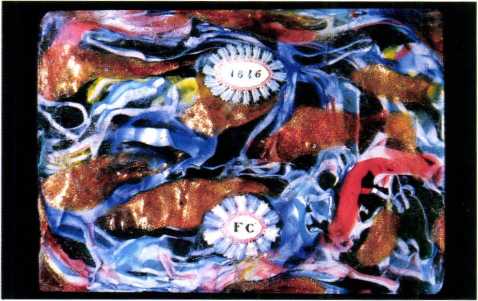
1.3 Antique sulphide bottles and tumblers
Western Asia. The secrets of the trade were so fiercely guarded that the growing number of glass- workers were forbidden by law to emigrate. In 1291 Venetian glassmakers were moved to the nearby island of Murano, where greater secrecy could be maintained and the dangers of uncontrolled furnace fires could be isolated.
Venetian glass [ 1.2,1.4,1.5] was known throughout the world, and Venetian glassmakers were eagerly sought by countries wishing to establish glass industries. By the late sixteenth century, Venetian glassmakers were the recognized leaders in glass craftsmanship and had established factories in several countries in Western Europe including France, Bohemia, and England.
Paperweights
Like the invention of glass itself, it is not known exactly when or where glass paperweights were first made. It is clear that the earliest glass paperweights were sulphides—sculpted ceramic cameos encased in crystal. The sulphide technique, which was first developed in France during the 1750s, was refined and perfected in England by Apsley Pellatt during the early 1800s. These glass incrustations usually commemorated important individuals and historic events; they were used to ornament paperweights as well as a variety of other glass objects [1.5]. Sulphides continued to be popular throughout the nineteenth century.
Although sulphides were the earliest type of paperweights made, the techniques used in millefiori paperweight making predate them. The term “millefiori,” meaning thousand flowers, appears first not during the Renaissance, as has been thought, but in early nineteenth-century Germany. According to the Oxford Dictionary, the term first appears in the English language in 1849, when Apsley Pellatt used it in his Curiosities of Glass Making, dated that year. The technique, however, has its origins in ancient Egypt. There it was utilized in mosaics, jewelry, and a variety of functional glass objects. During the early 1500s the Venetians revitalized and perfected the art of millefiori, producing some of the earliest millefiori- style paperweights.
In a tantalizing statement in De Situ Urbis Vene- tae, written about 1495, Marc Antonio Sabellico spoke of the manufacture of glass in his native Venice:
A famous invention first proved that glass might feign the whiteness of crystal, soon as the wits of men are active and not slothful in adding something to inventions, they began to turn the material into
variouscolours and numberless forms
There is no kind of precious stone which cannot be imitated by the industry7 of the glassworkers, a sweet contest of nature and of man . . . But, consider to whom did it first occur to include in a little ball all the sorts of flowers which clothe the meadows in spring.
1.6 Antique Baccarat concentric millefiori
Some believe that the major catalyst for production of paperweights in France came from the Exhibition ol Austrian Industry held in Vienna in 1845. It was there that Pietro Bigaglia of Venice, a Muranese glassworker, displayed his millefiori paperweights. Eugene Peligot, a professor at the Conservatoire des Arts etMetiers in Paris attended the Exhibition on behalf of the Parisian Chamber of Commerce and reported on Bigaglia’s weights when he returned to France:
Amongst the principal exhibits is that of Mr. Bigaglia of Venice . . . one notices round shaped millefioripaperw eights of transparent glass in which are inserted quantities of small tubes of all colors and forms assembled so as to look like a multitude of florets.
1.7 Baccarat tazza dated 1846
A few weights bearing Pietro Bigaglia’s initials are in existence today f 1.8]. These weights are usually abstract in design, containing bits and pieces of colored glass rods and occasionally portrait canes with initials, gondolas, or people.
Although the Exhibition of Austrian Industry undoubtedly played a role in the popularization of paperweights, some scholars believe that the millefiori paperweight process was being developed concurrently in Venice, France, and Bohemia during the early 1840s. Early Saint Louis weights that include 1845 dates surpass Venetian pieces of the same period, suggesting parallel rather than sequential development.
Bohemia (now in Czechoslovakia) was well known for its millefiori decorated objects as early as the 1830s. Although the earliest date found in Bohemian paperweights is 1848, the technical sophistication of these weights suggests that earlier pieces were being produced.
Perhaps historians will never agree on the exact time and place of the paperw eight origin. There is, however, no dispute about which country assumed the lead in paperw eight production. By 1845 France was the undeniable paperweight center of the world. There, most of the pieces created during the twenty-year classic period of paperweight making (1840-1860) were produced. In a remarkably short period of time, the French glass factories of Baccarat, Saint Louis, and Clichy had all perfected the millefiori technique. In addition, and of no less importance, they introduced and developed the lampwork style, to which the Pantin factory contributed some remarkable examples. The high quality and the range of styles and design motifs created in France during this time have never been surpassed.
English glass factories were quick to imitate the techniques and motifs of the French makers. Soon millefiori paperweights of considerable excellence were being produced by factories in London and Birmingham.
In the United States, the production of paperweights in large numbers did not begin until after the New York Exhibition of the Industry of All Nations, held in New York City in 1853. Many of
1.8 Venetian paperweight by Pietro Bigaglia
the early American weights were imitative of the French style: scrambled, close packed millefiori, and concentric in clear glass or on latticinio ground. However, the American makers were quick to contribute their own distinctive styles and techniques to paperweight making, particularly in the area of lampworking. In the Boston & Sandwich Glass Company and the New England Glass Company paperweight production was a regular part of company merchandise at this time.
After about 1860, interest in paperweights tapered off in France, Britain, and other European countries. It continued to flourish in America, with some production continuing intermittently into the early part of this century.
By the 1950s, paperweight making was on the verge of becoming a lost art. But the history of weights was irreversibly altered by one man and a bird in a nest.
Paul Jokelson relates, “In 1925 I was browsing along the Rue des Saints Peres in Paris, where antique shops abound, when I discovered what I later learned was a paperweight. I bought the “Bird in the Nest” because I liked it. But the dealer could tell me only a little about it, and I was intrigued. I went on to search for other paperweights in order to find out more about them. That is how I started, maybe how everyone starts. One paperweight and then it is done!”
Jokelson was soon on his way to collecting antique French paperweights and then sulphide
1.9 Paul Jokelson
weights. In 1953, by which time he was an importer and avid collector, he wanted a sulphide of General Eisenhower. He approached the glass factories of Baccarat and Saint Louis with the idea of reviving the classic art. This was a difficult and challenging proposition, since paperweights had not been produced in significant numbers for more than eighty years. Artists and craftsmen spent nearly twenty years in research and experimentation rediscovering the techniques used in making sulphide, millefiori, and lampwork paperweights. Once they succeeded, interest in contemporary paperweights blossomed.
In 1955, when Jokelson published Antique French Papenveights, paperweight collecting was limited to a few hundred persons. As more knowledge became available, more people joined the ranks of collectors, and their numbers steadily grew. Other
1.10 Antique millefiori weights from (top) Baccarat, Bacchus, and Saint Louis; (bottom) New England Glass Company, Clichy, and Bohemia
glass factories, such as Perthshire in Scotland, joined Baccarat and Saint Louis in producing fine quality modern paperweights. In addition, individual glass artists working in their own studios infused a new creativity and technology into the art of paperweight making.
The early pioneers in the paperweight movement had to overcome a shortage of materials, gaps in the body of knowledge, and other major stumbling blocks. But today, with the easy availability of colored and clear glass, modern tools, and vast improvements in glass and furnace technology7, they have the opportunity to improve on the past. Artists are bringing modern motifs to this
centuries-old craft, expanding a tradition with new and vital work.
These contemporary factories and studio artists are largely responsible for the current paperw eight renaissance. The finest work currently being produced has an unmistakable presence to it. There is an accompanying philosophical element that even enhances this presence. The quality is evident to both curators and collectors, who now number in the thousands. Considering the work of contemporary artists and the growing number of collections in museums and private homes, we are clearly in the midst of a vital and exciting new era in the art of the paperweight.
Fla -Z

1.11 Glasshouse, c. 1760, showing firing ofi clay pots
2.1 Workers changing a furnace pot at Saint Louis
CHAPTER TWO
Varieties and Methods
There were perhaps a hundred of them covering Wo tables situated on either side of the bed: crystal spheres imprisoning green lizards, salamanders, millefiori bouquets, dragonflies, a basket of pears, butterflies alighted on a frond of fern, swirls of pink and white and blue and white, shimmering like fireworks, cobras coiled to strike, pretty little arrangements of pansies, magnificent poinsettias.
At last Madame Colette said, “Ah, I see my snowflakes interest you?” Yes, I knew what she meant: these objects were rather like permanent snowflakes, dazzling patterns frozen forever. “Yes,” I said. “Beautiful. Beautiful. But what are they?”
—from The White Rose by Truman Capote
Paperweights are mysterious and intriguing objects. It is difficult for a person unfamiliar with these “small frozen gardens” to imagine how they are put together, for what purpose, and by whom. This chapter discusses how paperweights are made. It also provides specific information about the history and evolution of different types of weights, especially millefiori, lampwork, sulphide, Pinchbeck, bottle weights, and others. Specific information on the identification of weights is covered in Chapter Four.
The Making of a Paperweight
One of the most important factors in creating a fine paperweight is the quality of the glass. It is essential that a glassworker have the ability to control the weight, color, feel, and overall effect of the glass being used.
Glassmaking has historically been an extremely secretive process, with its formulas often passed down within families from one generation to the next. During the late 1700s, glassworkers at Cris- talleries de Saint Louis were forbidden to travel more than one league from the factory7 without permission; it was feared they would divulge glassmaking information or defect to some other glass factory. Even today, many glass factories and artists regard their glass formulas as trade secrets.
The basic ingredients in all glass are the same: sea sand and inorganic salts, such as soda and potassium nitrate [2.2]. In particularly high-quality colorless glass, called crystal, lead oxide is added to give brilliance and weight. Certain metallic oxides are added to obtain colored crystal. These colors
2.2 Raw materials for making glass

are made according to exact formulas specific to the factory.To begin to produce glass, all the components are mixed together and melted in large fireproof clay pots inside a furnace [2.3]. These clay pots must be replaced periodically [2.1] because the intense temperatures cause them to crack and corrode. Tiny pieces of clay can break off into the molten glass leaving imperfections or “stones” in the crystal. Paperweight maker Charles Kaziun described the fragile nature of these pots in an article published in the 1962 PCA Bulletin :
Glass pots are noted for their sensitivity to sudden changes of temperature and are subject to cracking while in use and leaking out the molten glass. Even before a pot is put into service it has been known to break just bringing it up to heat. Once the pot leaves the maker’s factory, all risks lie with the buyer except for obvious breakage that may occur in transit. However, some cracks only show up the first time it is heated and filled with batch only to have the glass run out. . . That is a sad day for that factory.
After the raw materials have been heated to temperatures exceeding 2600° Fahrenheit, the molten mixture is “boiled,” or stirred, to eliminate any imperfections in the melt and make the glass
2.5 Modern furnace at Parabelle Glass


2.7 Latticinio arranged on metal template
2.6 Melting premade glass slug with torch
2.8 Molten glass on pontil rod

more homogeneous. At this point, the glass is a red-hot liquid. As it cools to a working temperature, it can be manipulated and shaped with an array of special tools [2.4].
Paperweights may be constructed in two general ways depending on the kind of equipment used. Some glassworkers or factories have furnaces to produce molten glass [2.5]; others use torches or lamps to melt a slug of premade glass [2.6]. Yet, many aspects of the process are the same. Once the decorative elements, such as millefiori canes or lampwork figures, have been created, they are arranged on a metal template and heated to just below the melting point [2.7]. This is done to avoid cracking when hot glass is added. A metal collar is placed around the arrangement. The glassworker gathers a small ball of molten glass on the end of a long iron rod [2.8], rolling it and working it into shape on a metal plate or marver. The red-hot glass is then lowered into the collar to pick up the preheated design [2.9].
If the worker has a furnace, the canes or design elements are placed in the template face down [2.12]. They are picked up in this reverse position by the first gather of glass, which forms the ground of the paperweight [2.10]. If the glassworker uses a lamp or torch to make the decorative elements, they are placed in the collar in an upright position. Then the first gather flows in on top of the design, sometimes aided by a vacuum. The glass is blocked
2.12 Garland design assembled on metal template
2.9 Lowering molten glass into collar
2.10 Latticinio picked up by first gather
>1
2.11 Rolling latticinio into shape on marver
2.13 Heating a shaped and blocked weight
2.14 Gathering glass for dotne
2.16 View of dome while hot
2.17 Reheating weight in glory hole
2.19 Rollingpontil in chair
and shaped [2.13].
The piece is then reheated in the glory hole, which can be an opening in the heating oven or a separate fabricated unit [2.17]. This step allows for careful reheating of the glass. Another gather of clear molten glass is then added [2.14] to form the dome of the weight (in the case of furnace work) or the ground (in the case of lampwork). The lamp- worker must now attach a second pontil rod to the base and remove the original one.
From here the final blocking process begins. The worker rolls the pontil rod back and forth across the arms of his glass working chair so that the still-soft glass will not sag or become misshapen [2.19]. During this process the weight is
2.22 Giving a sharp tap to pontil
2.25 Weights cooling in annealing oven
2.24 Carrying weight to oven
2.23 Breaking off weight
2.26 The finished paperweight
shaped and smoothed with a wet wooden block or contoured pad of wet tissue or newspaper to form a smooth dome [2.20]. While the glass is still in this pliable state, tongs are used to form a slender neck at the base of the weight [2.21]. When the piece has cooled sufficiently the worker gives a sharp tap to the pontil rod [2.22]. The weight breaks off and falls into a bed of sand or a special device constructed to hold it [2.23].
The next step is to gradually and evenly cool the
2.27 Uncut millefiori canes
weight in an annealing oven [2.25]. This process is extremely delicate. Sometimes the gathers of glass and the design elements within a weight cool at different rates; then the piece shatters or cracks.
The final stage of the process is grinding and polishing. At this point the pontil mark, the scar made when the weight was separated from the pontil rod, is ground and polished. Often the dome of a weight can be faceted, that is, cut with a flat or rounded grinding wheel to form decorative windows for viewing the design.
A paperweight is hand crafted during each step of its creation. Even if many weights of the same design are made by a glass factory, each one is different.
Millefiori
The Italian word millefiori means “thousand flowers”; it is used to describe the decorative elements that make up the most well-known type of glass paperweights. Millefiori are small round cross sections of glass rods or canes showing a design or image [2.27]. In paperweights these glass slices are arranged, almost like pieces in a mosaic, to form the subject or pattern within a piece.
Prior to its use in paperweights of the midnineteenth century, millefiori was used as a decorative element in bowls, knife handles, pen holders, newel posts [2.28], seals, scent bottles, and other glassware of Italian origin. The earliest known objects containing millefiori decoration were made
MILLEFIORI 19
in ancient Egypt. Then the Romans and possibly the Greeks formed beautiful arabesques and other designs of mosaic glass. Ancient pavements were inlaid with small pieces of colored glass, some quite opaque, of various tints, put together with cement. Similarly small pieces of opaque enamel and glass were also used in great abundance to ornament the fountains of Pompeii.
The first step in making a millefiori paperweight is the production of a variety7 of glass rods or canes [2.29]. Using an iron pontil rod the glass- worker gathers molten glass from the furnace and works it into shape on a marver. If color is desired the gather is rolled in glass powders or color is gathered over the molten glass. It is then pressed into an iron mold [2.30-2.32]. The glass is then removed and another gather of molten glass is added. The piece is again worked on the marver and pressed into a mold of a different shape. This process can be repeated several times to build
2.30 Iron molds for millefiori
2.31 Molten glass plunged into mold
2.32 The glass fills the mold
2.33 The second pontil is attached
2.35 Arranging canes on template
layers of colors and designs within a cane.
At this stage the glass rod may be about three inches in diameter and six inches long. The piece is reheated and another glassworker attaches a second pontil to it [2.3 3]. The two workers quickly move apart, stretching the heated rod until it is pencil-thin and up to thirty feet long [2.34]. The design within the rod, no matter how intricate, is accurately miniaturized. However, only a small portion of the elongated rod is stretched evenly enough to be used. This choice section is sliced into tiny pieces that become the canes within a paperweight.
After the canes have been made they are arranged in a pattern on a metal template, heated with a hand or blow torch, and encased in glass [2.35, 2.36].
Types of Canes
There are several different types of canes used in paperweight design. Understanding how these canes are made can help in identifying a particular weight and evaluating its quality.
Canes made by pressing molten glass into molds and stretching them once are called simple canes. They often feature specific shapes such as circles,



